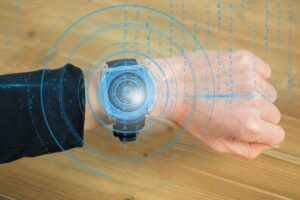
IoT in safety- IoT Revolutionizes Workplace Safety: A Comprehensive Guide
The Internet of Things (IoT) is a rapidly growing technology that involves connecting various devices and systems to the Internet and each other. IoT technology has the potential to revolutionize various industries, including safety. In industrial safety, IoT Industrial devices and systems can help monitor equipment, machinery, and workers in real-time, identify potential safety hazards, and provide alerts when equipment is operating outside of normal parameters or workers are in potentially hazardous situations. Predictive maintenance, hazardous material monitoring, emergency response, wearable technology, and worker safety training are some examples of how IoT can be used in industrial safety. Despite the potential benefits of IoT in safety, there are also challenges that need to be addressed, such as data privacy and security, integration with legacy systems, maintenance and upkeep, employee training, and cost.
However, with careful planning, investment, and implementation, IoT technology can significantly improve workplace safety, reduce the likelihood of accidents, and minimize the risk of injury or death for workers.
What is Industrial IoT?
The Industrial Internet of Things (IIoT) refers to the use of connected devices, sensors, and data analysis software to improve and automate industrial processes. IIoT enables industrial organizations to collect and analyze data from various sources, including machines, equipment, and production lines, in order to gain insights that can help optimize operations and reduce costs.
IIoT technology can be used in a wide range of industries, including manufacturing, logistics, transportation, energy, and more. Examples of IIoT applications include predictive maintenance of industrial equipment, real-time monitoring of production processes, remote asset tracking and management, and supply chain optimization.
One of the key benefits of IIoT is the ability to leverage data to make better decisions and improve efficiency. By collecting and analyzing data in real time, organizations can identify trends and patterns that can inform process improvements, identify potential issues before they become major problems, and optimize resource allocation to maximize output and minimize waste.
The potential role of IoT in industrial safety
The Internet of Things (IoT) has the potential to play a significant role in improving industrial safety. By using connected sensors and devices to collect data in real time, industrial organizations can identify potential hazards and take preventive action before accidents occur.
Here are some ways IoT can improve industrial safety:
Real-time monitoring: IoT in safety sensors can monitor equipment, machinery, and workers in real-time, providing alerts when equipment is operating outside of normal parameters or workers are in potentially hazardous situations.
Predictive maintenance: IoT sensors can monitor the condition of equipment and predict when maintenance is required, reducing the likelihood of equipment failure that could cause accidents.
Hazardous material monitoring: IoT sensors can monitor the storage and transport of hazardous materials, alerting workers if there are any potential leaks or spills that could pose a danger to human health and the environment.
Emergency response: IoT sensors can detect emergencies such as fires or gas leaks, and automatically trigger alarms or alerts to emergency responders.
Wearable technology: IoT-enabled wearable technology can track workers’ location, biometric data, and environmental conditions, allowing supervisors to identify and address potential health and safety risks.
Overall, the use of IoT in industrial safety can help reduce accidents and fatalities, improve compliance with safety regulations, and create a safer and more productive work environment for employees.

The Challenges for IoT in industrial safety
While the Internet of Things (IoT) has great potential to improve industrial safety, there are also several challenges that need to be addressed for successful implementation. Here are some of the key challenges:
Data privacy and security: IoT in safety systems rely on the collection, transmission, and storage of sensitive data, and any security breaches could have serious consequences. Industrial organizations need to ensure that they have strong security measures in place to protect against cyber threats.
Integration with legacy systems: Many industrial organizations have legacy equipment and systems that may not be compatible with IoT technology. The cost and complexity of integrating IoT with existing infrastructure can be a major challenge.
Maintenance and upkeep: IoT systems require regular maintenance and updates to ensure they continue to function properly. Organizations need to invest in ongoing maintenance and upkeep to ensure their systems are reliable and accurate.
Employee training: IoT systems require specialized knowledge and training to install, operate, and maintain. Organizations need to invest in training their employees to ensure they can effectively use and troubleshoot the IoT technology.
Cost: The cost of implementing an IoT system can be significant, especially for small and medium-sized businesses. Organizations need to weigh the cost of implementation against the potential benefits and ROI.
Overall, while there are challenges associated with implementing IoT in industrial safety, the potential benefits of improved safety and productivity make it worth pursuing. Addressing these challenges requires a holistic approach that considers the technical, organizational, and human factors involved in successful implementation.
What is the use of IoT in safety?
The use of IoT in safety can have several benefits, including improving workplace safety, reducing accidents, and minimizing the risk of injury or death. Here are some examples of how IoT can be used in safety:
Real-time monitoring: IoT sensors can monitor equipment, machinery, and workers in real-time, providing alerts when equipment is operating outside of normal parameters or workers are in potentially hazardous situations.
Predictive maintenance: IoT sensors can monitor the condition of equipment and predict when maintenance is required, reducing the likelihood of equipment failure that could cause accidents.
Hazardous material monitoring: IoT sensors can monitor the storage and transport of hazardous materials, alerting workers if there are any potential leaks or spills that could pose a danger to human health and the environment.
Emergency response: IoT sensors can detect emergencies such as fires or gas leaks, and automatically trigger alarms or alerts to emergency responders.
Wearable technology: IoT-enabled wearable technology can track workers’ location, biometric data, and environmental conditions, allowing supervisors to identify and address potential health and safety risks.
Worker safety training: IoT technology can be used to create virtual and augmented reality training programs to simulate dangerous work environments or emergency scenarios, allowing workers to practice safety procedures in a safe and controlled environment.
Overall, the use of IoT in safety can help improve workplace safety, reduce the likelihood of accidents, and minimize the risk of injury or death for workers.

What are the IoT devices for personal safety?
There are several IoT devices available for personal safety that can help individuals protect themselves in various situations. Here are some examples:
Personal alarms: These are small, portable devices that emit a loud noise when activated, which can help draw attention to an individual in distress.
Wearable devices: There are several wearable devices that can be used for personal safety, including smartwatches, fitness trackers, and personal safety devices. Some of these devices have features like GPS tracking, fall detection, and emergency SOS buttons.
Smart locks: Smart locks can be used to secure doors and windows, and some models have features like automatic locking and unlocking based on the user’s proximity.
Smart cameras: Smart cameras can be used for surveillance and to monitor the premises for any potential intruders or suspicious activity.
Panic buttons: Panic buttons can be installed in homes, offices, or public spaces and can be used to alert authorities or emergency services in case of an emergency.
Smart smoke detectors: Smart smoke detectors can detect smoke or fire and automatically alert the user and emergency services.
Overall, the use of IoT devices for personal safety can provide an additional layer of protection and peace of mind for individuals. However, it’s important to choose reliable and secure devices and to understand how to use them properly in case of an emergency.
Conclusion
In conclusion, the Internet of Things (IoT) has the potential to revolutionize various industries, including safety. By leveraging connected sensors, devices, and systems, IoT technology can help improve workplace safety, reduce the likelihood of accidents, and minimize the risk of injury or death for workers. Real-time monitoring, predictive maintenance, hazardous material monitoring, emergency response, wearable technology, and worker safety training are some examples of how IoT can be used in safety. However, there are also challenges that need to be addressed, including data privacy and security, integration with legacy systems, maintenance and upkeep, employee training, and cost. Despite these challenges, the potential benefits of using IoT in safety make it a promising area for further exploration and development.















